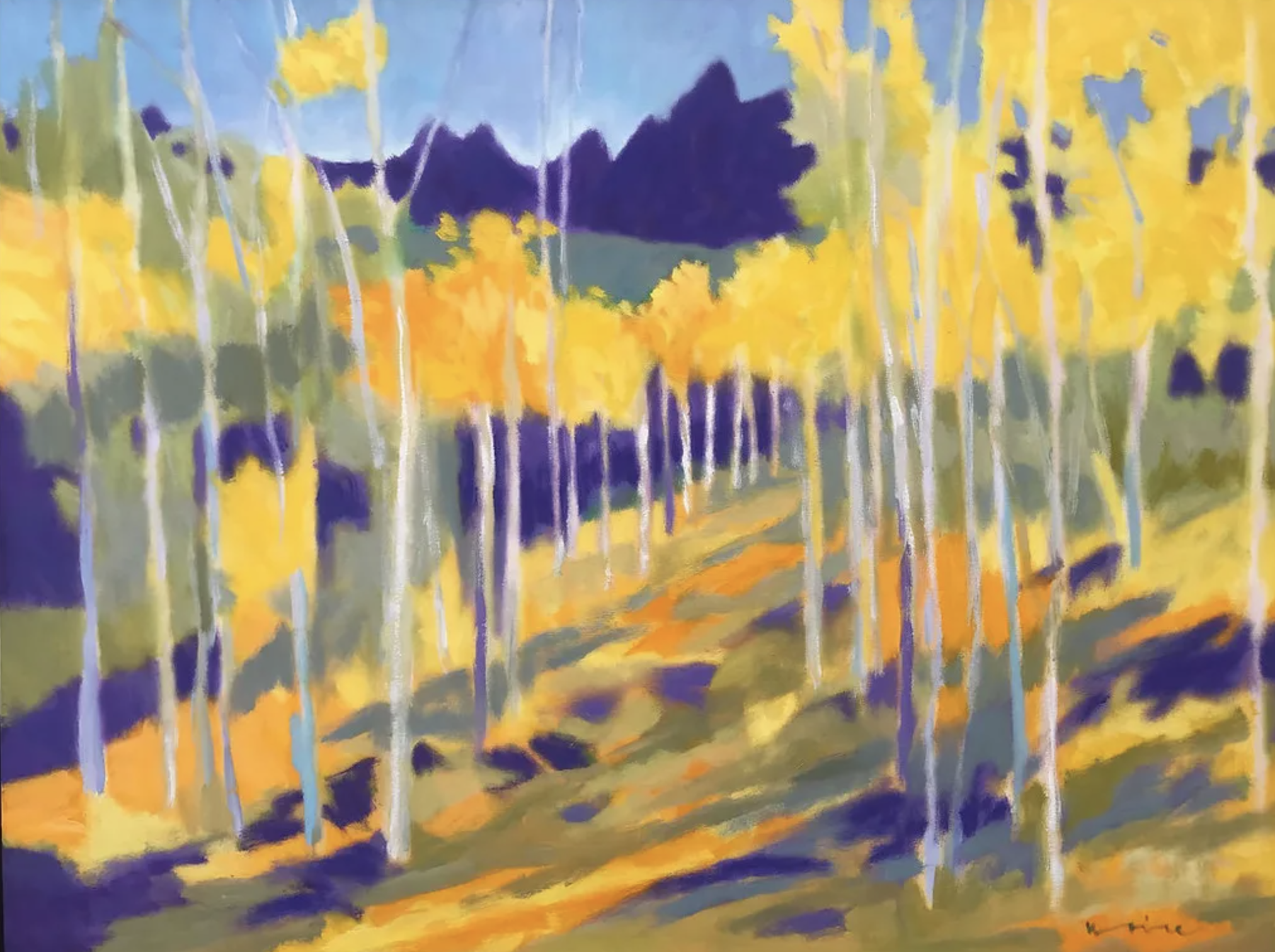
04 Sep Slate Gray September: Noice & McNair + Bling!
Telluride Arts’ Art Walk takes place Thursday, September 7. Participating venues are open 5-8pm, hosting receptions to introduce new exhibits and artists. Throughout the month Slate Gray Gallery presents “Curious by Nature” (front room) and “Offerings” (back room). For jewelry lovers, find the work of Maria Lightfoot and Nanci Modica.
Go here for more about Slate Gray.
Go here for more about Telluride Arts and Art Walk.
Please scroll down to read the email interviews of featured artists Marshall Noice and Julie McNair.

Oil and water? Chalk and cheese? At first glance, the two featured artists in Slate Gray’s upcoming shows would not seem to mix easily. Scratch the surface, however, and we find they are more like wine and chocolate, different yes, but a gratifying duo when enjoyed together.
Marshall Noice and Julie McNair share an intense and savvy joie de vivre which is reflected in their art. And while both are inspired by Mother Nature, Noice’s signature, shimmering pastoral abstractions leave us drunk on sensation. Julie’s evocative characters, on the other hand, are 3D metaphors, alternately poignant and heart-warming, often both, with her brand new series of sculptures underlining our complex relationship with our surroundings.
Marshall Noice:

Chet’s Young Maples
Marshall Noice never met a sky or a tree he did not like. For over three decades, the artist has been obsessed with landscapes. What we see in his work resembles the outside world the artist depicts much in the way a guitar case resembles a guitar: Noice is not painting a grove of trees for instance. He is depicting his emotional response to a grove of trees, which makes him an Expressionist for those who require an “ist” or an “ism.” – but one with Impressionistic flourishes and a Fauve sense of color.
Note: Expressionism is defined an art movement (and international tendency) that dates back to the beginning of the 20th century. The movement spanned literature, music, theatre and architecture as well as the visual arts. The aim of Expressionist artists was – and remains – to express an emotional experience, rather than a physical reality. Arguably the granddaddy of the movement was Vincent Van Gogh, now renowned for work that reflected a subjective view of the world.
“I capture a sense of place, but it’s my sense, my color. It’s delicate, because color is a strange animal. I work to create tone and value in an expressive way that resonates with me. At times, my color is almost outrageous – on the edge of being out of control.”
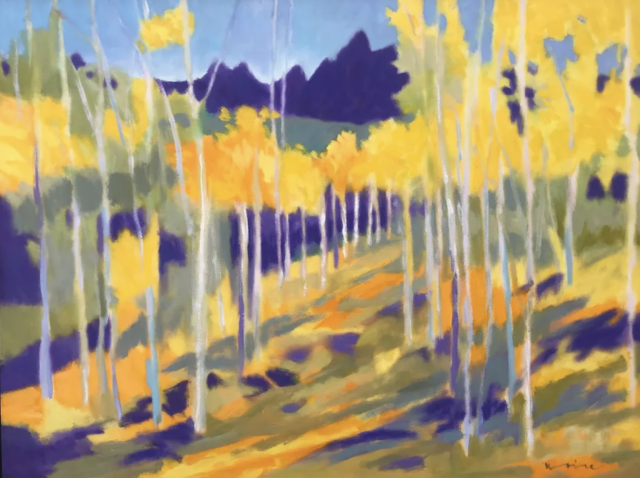
Elizabeth’s View
Since retiring as a professional photographer, Marshall Noice has earned a national following as a contemporary Expressionist artist with work in galleries in Santa Fe, Jackson Hole, Baltimore, Philadelphia, Chicago, Los Angeles, New York, and other hot spots such as Telluride.
Noice, who is a self-taught painter, has literally spent tens of thousands of hours perfecting his style in oils, working in his Kalispell, Montana studio five days a week when he is not on the road. Among his influences he lists Impressionist Pierre Bonnard, who made dreamy, abstracted landscapes of everyday life, and Abstract Expressionist Marc Rothko, who attempted to capture the spiritual resonance of a landscape in his color fields.
“Rothko had created edges that heightened the sense of luminosity. I believe he understood the use of light better than anyone else. Light just emanates from his paintings.”
For the slightly off-key way he deals with complementary colors to add dynamic tension to his work, Noice credits Joe Abbrescia.
But perhaps Noice’s greatest influence was Ansel Adams:
“From him I gained the ability to see light.”
Noice works on a dozen or more images at a time, allowing layers to dry before adding the next up to 1- to 15 applications of paint for texture and pop. It can be weeks, even years, before the artist declares a work done.
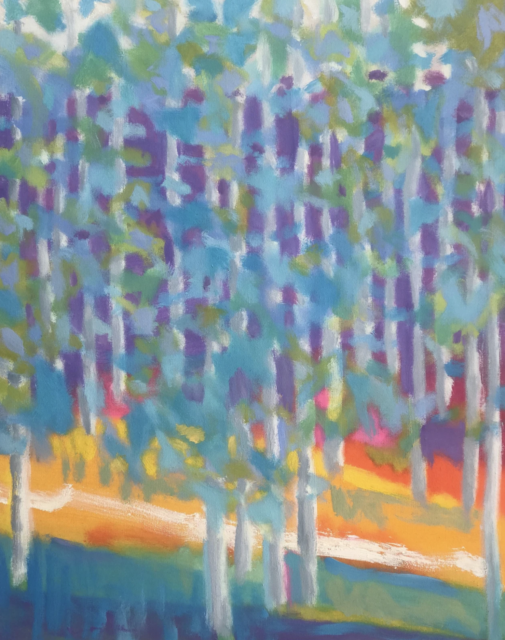
White Water, Rising
For more, check out our email interview:
TIO: Marshall, take us back to Little Marshall. Were you born to become an artist, genetically predisposed, or did something or someone in your world back then trigger you?
MN: I am absolutely engaged in the practice I was born to do. I have been an unrepentant maker of marks for a long as I can remember. My grandmother kept drawings I did before the age of three. Prior to kindergarten I was obsessed for a time with making tiny people and animals from plastelina. I built elaborate dioramas with hundreds of clay figures. At one point I had to go see the doctor because the skin on the palms of my hands was rubbed away from softening the clay.
As to a genetic predisposition, my mother had a degree in art education and my dad’s older brother was a successful commercial artist. But it was my dad’s twin brother, a notable jazz trumpeter, who inspired me to embark on my first career as a professional musician. But even when I was on the road the visual arts were part of my daily experience. I was always looking at the world through a camera lens; a sketch book and pen were always close at hand.
TIO: You were a professional photographer before becoming a professional painter. Had you gone to college with the intention of making photography your career?
MN: I studied photography at our local community college, The Banff Centre School of Fine Arts, and independently with Ansel Adams. I worked as a commercial photographer for 23 years, all the while maintaining a painting studio, where I also worked regularly.
TIO: As a photographer, did you occupy a particular niche?
MN: My primary interest was landscape photography executed in black-and-white.
TIO: Why the switch to painting? And to what extent, if any, did your photography influence your approach to painting? I recall Ansel Adams is a major influence.
MN: I didn’t exactly switch to painting. I had been painting all along. It was more a transition from making a living as a photographer to making a living as a painter. Photography in general and Ansel Adams in particular were a huge influence on how I see and how I depict the landscape. I learned to “see” landscapes from Ansel.
TIO: Please describe your process. Do your paintings begin with a photograph taken out in the field?
MN: I’m a studio painter. I enjoy making pastel sketches outdoors and often those sketches are the reference material I use for my paintings. I never work from photographs. My oils are done exclusively in the studio. It’s easier for me to make a painting that isn’t burdened by literal depiction if I’m not confronting the actual scene while I work.
TIO: In addition to Ansel Adams your influences include Pierre Bonnard, an Impressionist, and Mark Rothko, an AbExer. In what ways do you channel their disparate legacies?
It’s not really accurate to call Pierre Bonnard and Mark Rothko influencers. I unabashedly steal from both of them. Many of the color combinations in my work are taken directly from their paintings.
TIO: Why do you work on so many paintings at once?
MN: I am by nature a curious person. Frequently, when I’m in the thick of painting a picture, a question comes to mind. Typically it’s something like, “I wonder what it would look like if…” When that question arises, I start a painting or, at least, make a sketch, so the idea doesn’t disappear. I diligently honor every “what if” thought I’m given. It’s the essential part of my art practice that keeps dozens of unfinished paintings on my walls. And keeps my creative juices flowing.
Julie McNair: Offerings
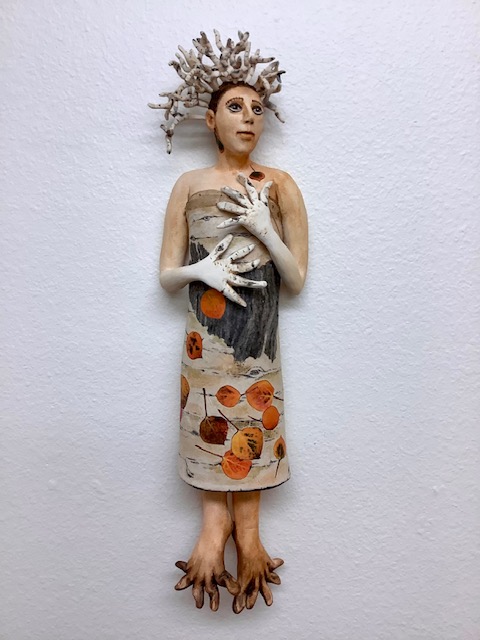
Autumn
Julie McNair sculptural forms are at once ironical and allegorical, personal and universal, but always, they are magically expressive and tinged with humor. (The artist is blessed with a rapier wit.)
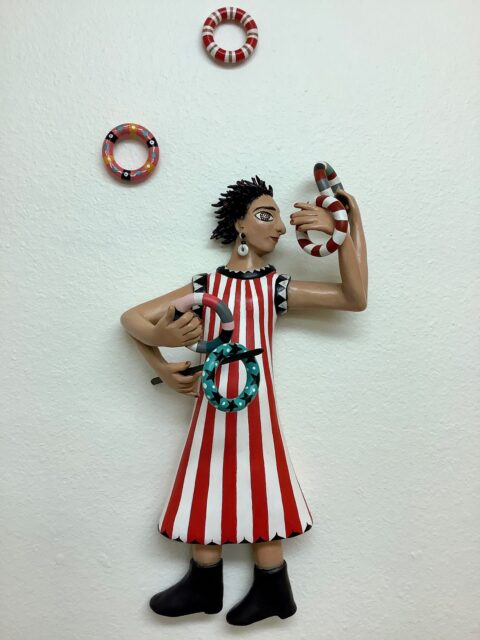
Flyer
For more than 30 years the figure has been prominent in Julie’s work, emerging in 2004 and incorporating the environment onto the surface to create a narrative reflective of our place in nature. But the artist remains more or less tight-lipped about her conclusions. In general, McNair leaves it up to us to say what condition our condition is in.

However, our email interview opens the door at least a crack into McNair’s prodigious and rich imagination:
TIO: What are your sculptural figures all about Julie?
JM: Many of the pieces are metaphors underlining the imbalance between humans and the natural world. Some are psychological studies seeking balance. But my latest body of work, “Offerings,” portrays a more harmonious relationship between humanity and the environment. I use mostly female forms to better express a nurturing element and suggest the need for more gratitude and love of the different and/or unique. A playful quality is still at the forefront. Finally, while my former figures were freestanding and well-grounded, the new work is aloft, designed to hang on the wall. These new pieces are also smaller, more detailed and more colorful. My use of mixed-media has also expanded, but I still use clay as the substructure.
TIO: To what extent did your formative years growing up immersed in fine Victorian antiques impact the future you?
JM: My grandmother always had projects and taught me to restore antiques from an early age. A departure from my family’s sense of beauty, however, came naturally. I was and remain more interested in the unique, twisted, asymmetrical way of seeing things, but still have respect for the detail work of the Victorian era.
TIO: Please talk process.
JM: Clay literally guides me and always takes me someplace new. Generally the work becomes a puzzle for me to solve. Once the form is created and fired, then I have a blank canvas but no clear narrative. It is in the finishing that everything comes together. I incorporate some glazing with oil pigments, acrylics, stolen ink (gel medium transfers), graphite, prisma colors, fire and anything that might create an interesting effect. The pieces are then titled to suggest a narrative – while leaving interpretation open.
TIO: You are a long-time resident of Telluride. How has living here influenced your work?
JM: The influence of living in Telluride since 1985 is primarily about nature – with my thoughts and feelings reflected in my figures. When I’m not in the studio, I love hiking, biking, boating, mushrooming and being outdoors in general.
If bling is your thing, the following two artists are master jewelers.
Mary Johnson (doing business as Maria Lightfoot):
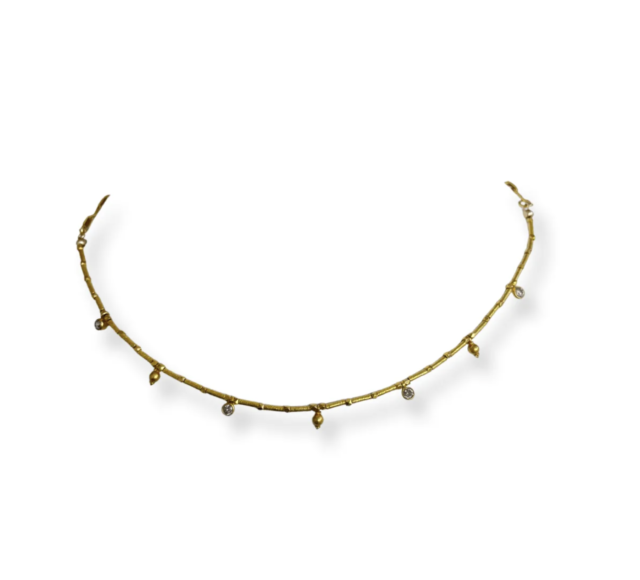
Diamond and gold chain
Mary Johnson arrived in the tie-dyed days of the town back in 1974.
“I loved travel, horses – and most of all being creative. I figured out a way to eke out a living at first by taking a caretaking job at the Adams Ranch under the auspices of the Telluride Ski Company. I boarded horses and had a place for my horses in exchange for irrigating and maintaining the property (now Telski’s golf course). I loved living in the mountains, my lifestyle, my friends. It was idyllic.”
Over the years Mary partnered or owned several stores in town, which variously featured antiques, home furnishings, tribal artifacts, antique textiles, handbags, some of which she crafted, some gleaned on her travels to Southeast and Central Asia and Latin America.
By 2010, Mary began connecting all the far-flung dots of her life by focusing on jewelry, a skill set, creative outlet and business, enhanced by the classes she took at Florida’s Ringling College of Art and Design.
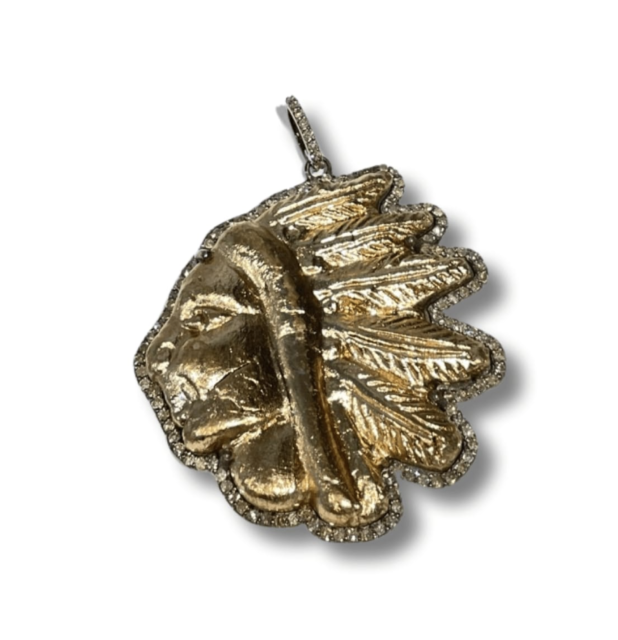
Chief’s Head Pendant
“I named my business The Maria Lightfoot Collection, a play on my married name, Mary Liekefet, and began designing and fabricating my line, which I wholesale to boutiques and galleries like Beth McLaughlin’s Slate Gray.”
The Maria Lightfoot Collection is a compilation of the different elements Mary loves: metals, leather, stones, antler, horn, bone.
“Basically I am inspired by whatever is right in front of me in the moment. And what tends to be in front of me are the goods I collected from all over the world relatively recently and long ago. My designs are all over the board: large statement pieces made from bone, African glass, leather and antlers, also old artifacts, amulets and prayer pouches. On the other end of the spectrum are my delicate pieces, mostly 24k gold, silver and bronze designs with diamonds. In between are my mixed metal shields, spikes and crescents, as well as an array of beaded strands.”
An original in her own right, Mary sees her customer as anyone “who love style and design and wants to stand apart from the crowd.”
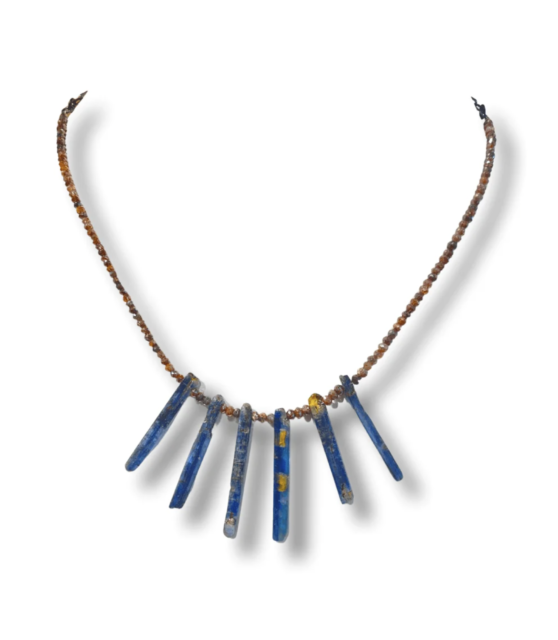
Kyanite spikes necklace
Nanci Modica:
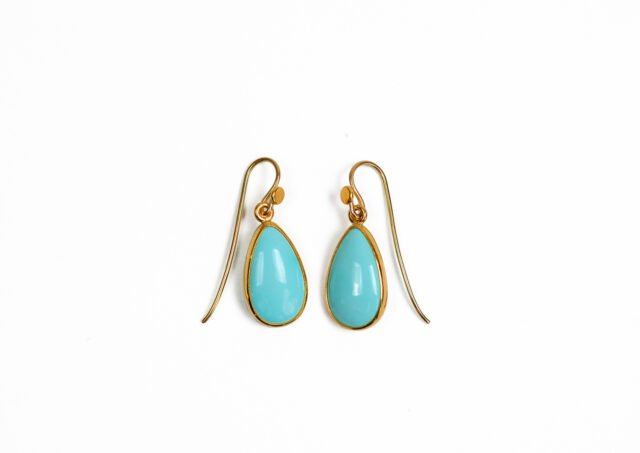
Turquoise teardrop earrings
Nanci Anne Modica was born and raised in the town of Manhasset on Long Island. Her father Frank Modica, a native New Yorker, was a jazz musician who played trumpet with big bands in the 1950s. He then moved on to become an agent for 20th-century musical greats such as Dizzy Gillespie, Miles Davis, Stan Getz, Sarah Vaughan, and Dave Brubeck, whom he represented for over 40 years.
Nanci began to study jewelry-making while still in high school, attending night and weekend classes at Parsons School of Design and Kulicke-Stark Academy in New York City where she studied under Robert Kulicke and Bessie Jamieson, owner of the Jewelry Arts Institute.
Nanci moved to Manhattan as a teen where she worked for the painter Keith Haring while continuing to learn the art of jewelry making. After Haring’s death in 1990 she began an apprenticeship in classical jewelry construction with Bessie Jamieson, who would become a lifelong mentor.
Nanci’s work with Jamieson included assisting with demonstrations of ancient jewelry construction techniques during the “Greek Gold” exhibit at the Metropolitan Museum of Art in 1992. She also worked as a teaching assistant, demonstrating jewelry making in the Bard College graduate program and at the World Gold Council.
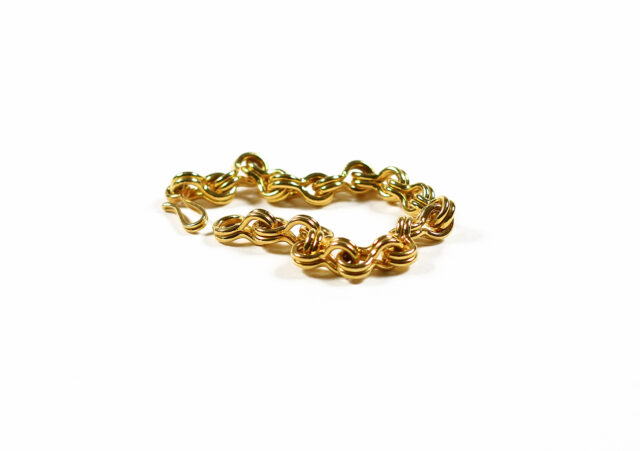
Grand Sailor’s Knot bracelet
After completing her apprenticeship in 1994, Nanci continued as a full-time instructor at Jewelry Arts until 2003 when she launched Lunula* Studios, located in the Soho District of Manhattan and specializing in high karat Classical and contemporary gold jewelry.
At Lunula, Nanci collaborated with top goldsmiths to create pieces for galleries and private clients while continuing to teach and make jewelry on her own. Between 2010 and 2014 she partnered with jewelers Bikakis and Johns, with whom she shared a 20-year relationship.
In 2014, Nanci moved her studio from downtown Manhattan to the Vinegar Hill section of Brooklyn, also known as DUMBO, which is the home of Atelier Modica. And, after 32 years, she continues to work closely with Jamieson.
Nanci is an avid cyclist and a founder of the all-female competitive cycling team Radical Media Racing. She lives in Hell’s Kitchen with her husband Jesus Perera and their son Frankie.

Emerald & diamond ring


Sorry, the comment form is closed at this time.